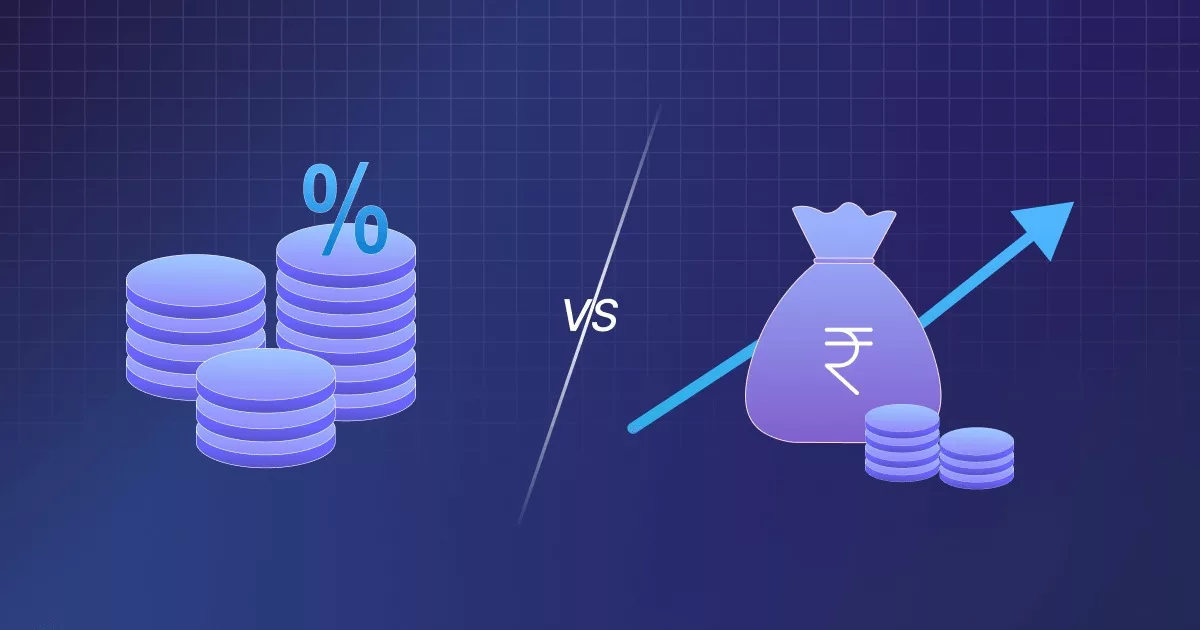
Money is a fundamental aspect of our lives, and we interact with it on a daily basis. Interest is an important concept in the financial world. This is because it affects how much money we earn or pay back when we borrow or invest. Two common types of interest are simple interest and compound interest. And it is important to understand the differences between the two. In this article, we will explore the key characteristics, calculations, and applications of simple and compound interest. Whether you are looking to borrow money, invest in a savings account, or plan for your retirement, this will provide you with the knowledge you need to make informed financial decisions.
What Is Simple Interest?
Simple interest is a basic method of calculating interest on a principal amount that remains constant throughout the term of the loan. It is the interest you have to pay on the principal amount borrowed, and it depends on the principal amount, interest rate, and time period.
1. How to calculate it
The formula for calculating simple interest is straightforward: Simple Interest = Principal x Rate x Time. Here, Principal refers to the amount you borrow, Rate is the interest rate you must pay, and Time is the duration for which you’ve taken the loan. The interest amount calculated through this method remains the same throughout the loan repayment period.
2. Examples of simple interest in finance
Simple interest is commonly used in finance for short-term loans such as personal loans, car loans, and small business loans. For instance, if a person borrows $10,000 for a period of 5 years with an annual interest rate of 5%, the interest amount charged would be $2,500. This interest amount remains the same throughout the loan repayment period, and the borrower needs to pay it back along with the principal amount.
What Is Compound Interest?
Compound interest is the interest calculated on the initial amount and the accumulated interest from previous periods. Unlike simple interest, compound interest includes interest on interest, leading to exponential growth over time.
1. How it is calculated
The formula for calculating compound interest is A = P(1 + r/n)^(nt), where A is the final amount, P is the principal amount, r is the interest rate, n is the number of times the interest is compounded in a year, and t is the number of years.
2. Examples of compound interest in finance
Compound interest is commonly used in various financial instruments such as savings accounts, mutual funds, and bonds. For example, suppose you invest $1000 in a mutual fund with an annual interest rate of 5% compounded monthly. After one year, the investment would be worth $1,051.16. The compound interest earned over the year would be $51.16. Similarly, if you take out a loan with a 10% interest rate compounded annually, the interest charged will increase each year, resulting in a higher debt burden over time.
Difference between Simple Interest and Compound Interest
1. Calculation methods
Simple interest is calculated on the principal amount only, while compound interest is calculated on the principal plus the accumulated interest. Simple interest is calculated as P x R x T, while compound interest is calculated as P x (1 + R/N)^(N x T), where P is the principal, R is the interest rate, T is the time period, and N is the number of compounding periods.
2. Interest compounding
In simple interest, interest is not compounded, and the interest amount remains constant throughout the loan or investment period. In compound interest, interest is compounded at regular intervals, and the interest amount increases over time.
3. Loan repayment
In simple interest, the interest amount remains the same throughout the loan period, while in compound interest, the interest amount increases over time. This means that the total amount repaid in simple interest is lower than that in compound interest.
4. Investment growth
In simple interest, the investment growth is linear, and the return on investment remains the same over time. In compound interest, the investment growth is exponential, and the return on investment increases over time due to the effect of compounding.
5. Savings account interest
In a savings account, simple interest is usually applied, and the interest amount remains the same throughout the savings period. However, some savings accounts may apply compound interest, in which case the interest amount increases over time due to the effect of compounding.
Benefits and Drawbacks of Simple Interest
Benefits
1. Predictability
One of the benefits of simple interest is its predictability. Since the interest rate is fixed, borrowers and lenders can easily determine the amount of interest to be paid or received over the loan or investment period.
2. Simplicity
Simple interest is easy to understand and calculate. It involves straightforward arithmetic calculations and does not require complex formulas or calculations.
Drawbacks
1. Lack of compounding
One of the drawbacks of simple interest is the lack of compounding. Interest is calculated only on the principal amount and does not include any interest earned on previously accumulated interest.
2. Limited growth potential
Another drawback of simple interest is its limited growth potential. Since interest is not compounded, the total amount of interest earned or paid is lower than the potential returns of compound interest.
Overall, simple interest is a good option for borrowers and lenders who prefer predictability and simplicity over growth potential. However, those seeking higher returns or savings may opt for compound interest instead.
Benefits and Drawbacks of Compound Interest
Benefits
1. Compounding growth
Compound interest allows for the growth of investments, savings, or loans to be compounded over time, resulting in exponential growth. As interest is added to the principal amount, it earns interest on both the principal and accumulated interest.
2. Higher interest rates
Compound interest usually offers higher interest rates than simple interest, which can lead to higher returns on investments and savings or faster loan repayment.
Drawbacks
1. Loan and investment growth potential
Compound interest can help investments and savings grow over time, leading to larger payouts in the future. On the other hand, loans with compound interest can accumulate more debt due to interest compounding over the repayment period.
2. Potential debt accumulation
With compound interest, debt can accumulate quickly over time due to the compounding of interest. This can lead to you owing a larger amount in the long run if you don’t pay off the debt in a timely manner.
Applications of Simple and Compound Interest
1. Loans
Simple and compound interest are common terms in the world of loans. A simple interest loan is where interest is applicable only on the principal amount of the loan. In contrast, a compound interest loan is where the interest is applicable on the principal amount as well as the interest accumulated till that point. Simple interest is a common thing in short-term loans, such as payday loans or car title loans. Meanwhile, compound interest is more common in long-term loans, such as mortgages.
2. Savings Accounts
Savings accounts are a popular way for individuals to earn interest on their money. Simple interest is usually a thing on savings accounts, where you receive interest only on the principal amount deposited. Some financial institutions also offer compound interest, where they calculate interest on both the principal and the accumulated interest. Compound interest is beneficial for long-term savings goals, as it allows the account to grow at a faster rate over time.
3. Investments
Both simple and compound interest are a common factor in investments. In simple interest investments, you earn interest only on the principal amount invested. In compound interest investments, you earn interest on the principal amount as well as the accumulated interest. You often get compound interest on long-term investments, such as retirement accounts or mutual funds. This is because it allows for greater growth potential over time.
4. Credit Cards
Credit cards often come with high-interest rates and fees. Most credit cards use compound interest to calculate interest charges on the unpaid balance. This means that interest is charged not only on the principal amount but also on the interest accrued on that amount. It is important for credit card users to understand how compound interest works and to pay off their balances in full each month to avoid accumulating debt.
Challenges and Limitations of Simple and Compound Interest
1. Fluctuating Interest Rates
Fluctuating interest rates can be a challenge for both simple and compound interest calculations, as they can impact the total amount of interest paid or earned over time. In the case of loans, fluctuating interest rates can make it difficult for borrowers to accurately predict their monthly payments and repayment timeline. For investments, fluctuating interest rates can affect the total return on investment and make it difficult for investors to accurately predict their earnings. This can make it challenging for individuals and businesses to effectively plan their finances and make informed financial decisions.
2. Unpredictable Growth
Both simple and compound interest may be subject to unpredictable growth, which can impact the total amount of interest earned or paid. In the case of savings accounts and investments, unpredictable growth can result in lower returns than expected, potentially impacting long-term financial goals. Unpredictable growth can also make it difficult for borrowers to accurately estimate the total cost of a loan over time, leading to unexpected financial strain. This can make it challenging for individuals and businesses to make informed financial decisions and effectively plan for the future.
3. Debt Accumulation
In the case of compound interest, debt accumulation can be a significant challenge for borrowers. Over time, compounding interest can result in significantly higher amounts of debt, making it more difficult for borrowers to repay loans and manage their finances. In some cases, compound interest can result in a debt spiral, where borrowers are unable to repay their loans and interest continues to accumulate. This can have a negative impact on credit scores and make it challenging for individuals and businesses to access credit in the future. Simple interest, on the other hand, may offer borrowers more predictable repayment terms and lower overall debt accumulation.
Conclusion
Simple interest and compound interest are two different concepts that play a crucial role in the world of finance. Simple interest is easy to calculate and predict, making it an attractive option for those who want a fixed payment schedule. However, it lacks the compounding growth potential of compound interest. Compound interest, on the other hand, can result in significant growth potential for investments and savings accounts but also carries the risk of debt accumulation.
Ultimately, the decision to use simple or compound interest depends on an individual’s financial goals and circumstances. Understanding the benefits and limitations of each can help individuals make informed decisions and achieve their financial goals.
FAQs
1. What is the Annual Percentage Rate (APR)?
The Annual Percentage Rate (APR) is the yearly interest rate that a borrower pays on a loan, including any fees or charges associated with the loan. It is expressed as a percentage of the total loan amount and is used to determine the total cost of borrowing over the life of the loan.
2. How does interest compounding work?
Interest compounding is the process of earning interest on both the principal amount and the accumulated interest earned on that principal amount. The interest earned is added to the principal, and subsequent interest calculations are based on the new, higher principal amount. This results in the exponential growth of the investment or debt over time.
3. What are some strategies to maximize interest growth?
Strategies to maximize interest growth include investing in accounts or assets that offer high interest rates or compounding, avoiding fees or penalties that can reduce interest earnings, making regular contributions or deposits to the account, and keeping funds invested for longer periods of time to allow for compounding growth. It is also important to consider the risks associated with each investment option and to diversify the portfolio to reduce risk.




